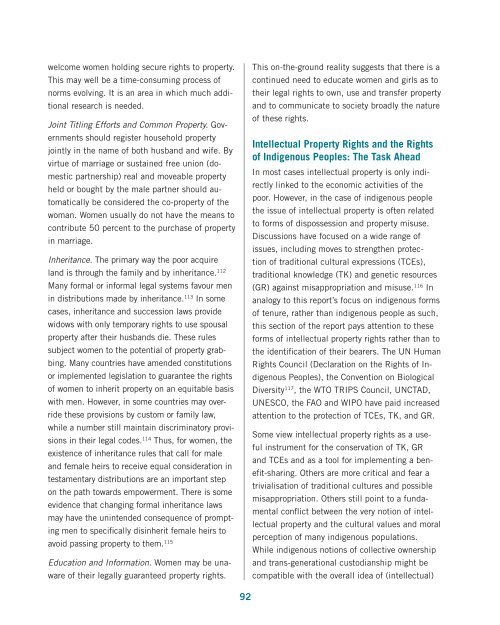Download the file - United Nations Rule of Law
Download the file - United Nations Rule of Law
Download the file - United Nations Rule of Law
Create successful ePaper yourself
Turn your PDF publications into a flip-book with our unique Google optimized e-Paper software.
welcome women holding secure rights to property.This may well be a time-consuming process <strong>of</strong>norms evolving. It is an area in which much additionalresearch is needed.Joint Titling Efforts and Common Property. Governmentsshould register household propertyjointly in <strong>the</strong> name <strong>of</strong> both husband and wife. Byvirtue <strong>of</strong> marriage or sustained free union (domesticpartnership) real and moveable propertyheld or bought by <strong>the</strong> male partner should automaticallybe considered <strong>the</strong> co-property <strong>of</strong> <strong>the</strong>woman. Women usually do not have <strong>the</strong> means tocontribute 50 percent to <strong>the</strong> purchase <strong>of</strong> propertyin marriage.Inheritance. The primary way <strong>the</strong> poor acquireland is through <strong>the</strong> family and by inheritance. 112Many formal or informal legal systems favour menin distributions made by inheritance. 113 In somecases, inheritance and succession laws providewidows with only temporary rights to use spousalproperty after <strong>the</strong>ir husbands die. These rulessubject women to <strong>the</strong> potential <strong>of</strong> property grabbing.Many countries have amended constitutionsor implemented legislation to guarantee <strong>the</strong> rights<strong>of</strong> women to inherit property on an equitable basiswith men. However, in some countries may override<strong>the</strong>se provisions by custom or family law,while a number still maintain discriminatory provisionsin <strong>the</strong>ir legal codes. 114 Thus, for women, <strong>the</strong>existence <strong>of</strong> inheritance rules that call for maleand female heirs to receive equal consideration intestamentary distributions are an important stepon <strong>the</strong> path towards empowerment. There is someevidence that changing formal inheritance lawsmay have <strong>the</strong> unintended consequence <strong>of</strong> promptingmen to specifically disinherit female heirs toavoid passing property to <strong>the</strong>m. 115Education and Information. Women may be unaware<strong>of</strong> <strong>the</strong>ir legally guaranteed property rights.This on-<strong>the</strong>-ground reality suggests that <strong>the</strong>re is acontinued need to educate women and girls as to<strong>the</strong>ir legal rights to own, use and transfer propertyand to communicate to society broadly <strong>the</strong> nature<strong>of</strong> <strong>the</strong>se rights.Intellectual Property Rights and <strong>the</strong> Rights<strong>of</strong> Indigenous Peoples: The Task AheadIn most cases intellectual property is only indirectlylinked to <strong>the</strong> economic activities <strong>of</strong> <strong>the</strong>poor. However, in <strong>the</strong> case <strong>of</strong> indigenous people<strong>the</strong> issue <strong>of</strong> intellectual property is <strong>of</strong>ten relatedto forms <strong>of</strong> dispossession and property misuse.Discussions have focused on a wide range <strong>of</strong>issues, including moves to streng<strong>the</strong>n protection<strong>of</strong> traditional cultural expressions (TCEs),traditional knowledge (TK) and genetic resources(GR) against misappropriation and misuse. 116 Inanalogy to this report’s focus on indigenous forms<strong>of</strong> tenure, ra<strong>the</strong>r than indigenous people as such,this section <strong>of</strong> <strong>the</strong> report pays attention to <strong>the</strong>seforms <strong>of</strong> intellectual property rights ra<strong>the</strong>r than to<strong>the</strong> identification <strong>of</strong> <strong>the</strong>ir bearers. The UN HumanRights Council (Declaration on <strong>the</strong> Rights <strong>of</strong> IndigenousPeoples), <strong>the</strong> Convention on BiologicalDiversity 117 , <strong>the</strong> WTO TRIPS Council, UNCTAD,UNESCO, <strong>the</strong> FAO and WIPO have paid increasedattention to <strong>the</strong> protection <strong>of</strong> TCEs, TK, and GR.Some view intellectual property rights as a usefulinstrument for <strong>the</strong> conservation <strong>of</strong> TK, GRand TCEs and as a tool for implementing a benefit-sharing.O<strong>the</strong>rs are more critical and fear atrivialisation <strong>of</strong> traditional cultures and possiblemisappropriation. O<strong>the</strong>rs still point to a fundamentalconflict between <strong>the</strong> very notion <strong>of</strong> intellectualproperty and <strong>the</strong> cultural values and moralperception <strong>of</strong> many indigenous populations.While indigenous notions <strong>of</strong> collective ownershipand trans-generational custodianship might becompatible with <strong>the</strong> overall idea <strong>of</strong> (intellectual)92
















